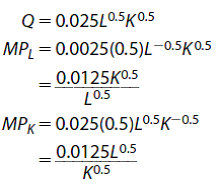
Managerial Economics 12th Edition by Mark Hirschey
Edition 12ISBN: 978-1439042144
Managerial Economics 12th Edition by Mark Hirschey
Edition 12ISBN: 978-1439042144 Exercise 2
Fixed Input Combinations. Cherry Devices, Inc., assembles connectors and terminals for electronic products at a plant in New Haven, Connecticut. The plant uses labor ( L ) and capital ( K ) in an assembly line process to produce output ( Q ), where

A. Calculate how many units of output can be produced with 4 units of labor and 400 units of capital and with 16 units of labor and 1,600 units of capital. Are returns to scale increasing, constant, or diminishing?
B. Calculate the change in the marginal product of labor as labor grows from 4 to 16 units, holding capital constant at 400 units. Similarly, calculate the change in the marginal product of capital as capital grows from 400 to 1,600 units, holding labor constant at 4 units. Are returns to each factor increasing, constant, or diminishing?
C. Assume now and throughout the remainder of the problem that labor and capital must be combined in the ratio 4L:400K. How much output could be produced if Cherry has a constraint of L = 4,000 and K = 480,000 during the coming production period?
D. What are the marginal products of each factor under the conditions described in part C?

A. Calculate how many units of output can be produced with 4 units of labor and 400 units of capital and with 16 units of labor and 1,600 units of capital. Are returns to scale increasing, constant, or diminishing?
B. Calculate the change in the marginal product of labor as labor grows from 4 to 16 units, holding capital constant at 400 units. Similarly, calculate the change in the marginal product of capital as capital grows from 400 to 1,600 units, holding labor constant at 4 units. Are returns to each factor increasing, constant, or diminishing?
C. Assume now and throughout the remainder of the problem that labor and capital must be combined in the ratio 4L:400K. How much output could be produced if Cherry has a constraint of L = 4,000 and K = 480,000 during the coming production period?
D. What are the marginal products of each factor under the conditions described in part C?
Explanation
The labor (L) and capital (K) functions ...
Managerial Economics 12th Edition by Mark Hirschey
Why don’t you like this exercise?
Other Minimum 8 character and maximum 255 character
Character 255



